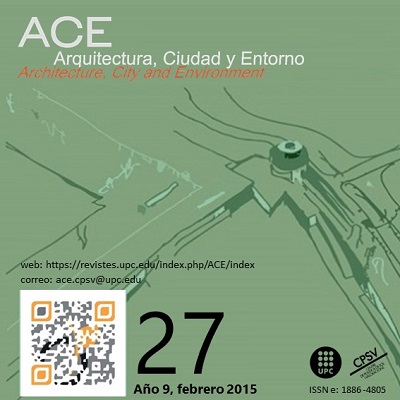Do the vertical condominiums benefit equally the value of its neighboring buildings? An analysis to Ñuñoa, Santiago de Chile
DOI:
https://doi.org/10.5821/ace.9.27.3841Keywords:
Real estate assessment, hedonic prices, gated communities, vertical condominiums.Abstract
Several studies have shown the market premium of dwellings located within gated communities; however, no or little attention has received the effect they produce on the price of houses that surround them. This issue is very important in cities in which gated communities or other type of common interest housing communities aimed at upper-middle socioeconomic strata are confined to traditionally lower income places. From a qualitative perspective Salcedo and Torres (2004) and Caceres and Sabatini (2004) have suggested that this social proximity produces many benefits, among others, expectations of appreciation of floor of the original settlers. This research attempts to measure the impact produced by vertical condominiums recently constructed on the price of houses using an hedonic price model, based on information of used dwellings sold in Ñuñoa between 2002 and 2004. The results suggest that a medium sized condominium produces a revaluation of 4.7% in dwellings around them; although this is a local impact. The spatial analysis of the data using a geographically weighted model reveals that the marginal appreciation is higher in areas with higher incomes, whereby the patrimony of the most creditworthy households further increases its value. Therefore, the impact of the condominiums of Ñuñoa may increase tax revenues derived from the tax on land ownership; but is far from democratizing, at the microscale, the spatial distribution of housing values.
Downloads
Published
Issue
Section
License
| INTELECTUAL PROTECTION CRITERIA |
At this moment, it is count with the "Oficina Española de Patentes y Marcas", while global protection it is being processed by the World Intelectual Property Organization (OMPI/WIPO). Nevertheless the International Standard Serial Number Office (ISSN) has given the following numbers ISSN: 1886-4805 (electronic version) and 1887-7052 (paper version). All articles will be peer reviewed, using double blind reviewing. |
| COPYRIGHT |
The article contents and their comments are authors exclusive liability, and do not reflect necessarily the journal editor commitee's opinion. All ACE published works are subject to the following licence CC BY-NC-ND 3.0 ES http://creativecommons.org/licenses/by-nc-nd/3.0/es/ It implies that authors do not hold nor retain the copyright without restrictions but only those included in the licence. |





































